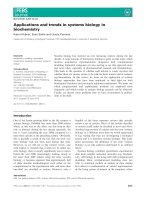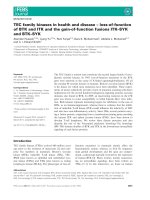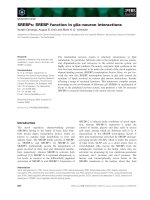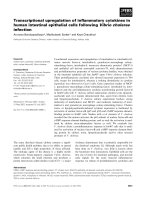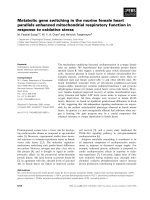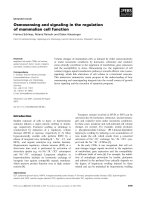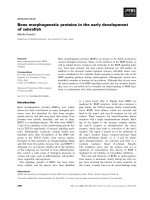Báo cáo khoa học: Fasting-induced oxidative stress in very long chain acyl-CoA dehydrogenase-deficient mice pdf
Bạn đang xem bản rút gọn của tài liệu. Xem và tải ngay bản đầy đủ của tài liệu tại đây (288.78 KB, 10 trang )
Fasting-induced oxidative stress in very long chain
acyl-CoA dehydrogenase-deficient mice
Sara Tucci, Sonja Primassin and Ute Spiekerkoetter
Department of General Pediatrics, University Children’s Hospital, Duesseldorf, Germany
Introduction
Very long chain acyl-CoA dehydrogenase (VLCAD)
catalyzes the first reaction of the mitochondrial b-oxi-
dation of long-chain fatty acids. Dysfunction and
deficiency of this enzyme represents the most common
b-oxidation defect of long-chain fatty acids, with an
incidence of one in 55 000 to one in 100 000 births [1].
VLCAD deficiency (VLCADD) presents heterogeneous
clinical phenotypes, with different severities and ages
of onset, and involvement of different organ systems
[2,3]. Catabolic stress or intensive physical exercise,
Keywords
fatty acid oxidation; hepatopathy; medium-
chain triglyceride (MCT); oxidative stress;
very long chain acyl-CoA dehydrogenase
(VLCAD) deficiency
Correspondence
S. Tucci, Department of General Pediatrics,
University Children’s Hospital,
Moorenstraße 5, D-40225 Duesseldorf,
Germany
Fax: +49 211 811 6969
Tel: +49 211 811 7685
E-mail:
(Received 16 June 2010, revised
1 September 2010, accepted
9 September 2010)
doi:10.1111/j.1742-4658.2010.07876.x
Hepatopathy and hepatomegaly as consequences of prolonged fasting or
illnesses are typical clinical features of very long chain acyl-CoA dehydro-
genase (VLCACD) deficiency, the most common long-chain fatty acid
b-oxidation defect. Supplementation with medium-chain triglycerides (MCTs)
is an important treatment measure in these defects, in order to supply suffi-
cient energy. Little is known about the pathogenetic mechanisms leading to
hepatopathy. Here, we investigated the effects of prolonged fasting and an
MCT diet on liver function. Wild-type (WT) and VLCAD knockout mice
were fed with either a regular long-chain triglyceride diet or an MCT diet
for 5 weeks. In both groups, we determined liver and blood lipid contents
under nonfasting conditions and after 24 h of fasting. Expression of genes
regulating peroxisomal and microsomal oxidation pathways was analyzed
by RT-PCR. In addition, glutathione peroxidase and catalase activities, as
well as thiobarbituric acid reactive substances, were examined. In VLCAD
knockout mice fed with a long-chain triglyceride diet, fasting is associated
with excessive accumulation of liver lipids, resulting in hepatopathy and
strong upregulation of peroxisomal and microsomal oxidation pathways as
well as antioxidant enzyme activities and thiobarbituric acid reactive sub-
stances. These effects were even evident in nonfasted mice fed with an
MCT diet, and were particularly pronounced in fasted mice fed with an
MCT diet. This study strongly suggests that liver damage in fatty acid
oxidation defects is attributable to oxidative stress and generation of reac-
tive oxygen species as a result of significant fat accumulation. An MCT
diet does not prevent hepatic damage during catabolism and metabolic
derangement.
Abbreviations
AOX, acyl-CoA oxidase; CYP4A1, cytochrome P450 gene 4 subfamily A polypeptide 1; GPX, glutathione peroxidase; GSH, reduced
glutathione; HDL, high-density lipoprotein; KO, knockout; LCT, long-chain triglyceride; LDL, low-density lipoprotein; MCT, medium-chain
triglyceride; SEM, standard error of the mean; TBARS, thiobarbituric acid reactive substances; TG, triglyceride; VLCAD, very long chain
acyl-CoA dehydrogenase; VLCADD, very long chain acyl-CoA dehydrogenase deficiency; VLDL, very low density lipoprotein; WT, wild type.
FEBS Journal 277 (2010) 4699–4708 ª 2010 The Authors Journal compilation ª 2010 FEBS 4699
when energy production increasingly relies on fat
metabolism, may induce or aggravate clinical symp-
toms and progress to severe metabolic derangement.
Hypoketotic hypoglycemia, hepatomegaly, hepatopa-
thy, Reye-like symptoms and hepatic encephalopathy
are typical clinical features of prolonged fasting or
of illnesses. Moreover, cardiomyopathy and skeletal
myopathy also occur in long-chain fatty acid oxidation
defects [4]. During these catabolic situations, long-
chain fatty acids cannot be oxidized, and accumulate
in tissues as long-chain acyl-CoAs and acylcarnitines
[5]. However, despite the well-known mechanism of
long-chain acylcarnitine accumulation, the conse-
quences of prolonged fasting for liver lipid metabolism
and liver function are poorly defined.
Medium-chain triglycerides (MCTs) have been
reported to bypass the first step of b-oxidation cata-
lyzed by VLCAD, and can be fully metabolized [6,7].
Therefore, treatment recommendations for VLCADD
include avoidance of fasting, and a long-chain triglyc-
eride (LCT)-restricted and fat-modified diet, in which
LCTs are completely or in part replaced by MCTs
[7–9]. Supplementation with MCTs has been proven to
be especially effective in cardiac and myopathic pheno-
types [10].
The effects of dietary intervention in VLCADD can
be easily studied with the VLCAD knockout (KO)
mouse model, that has similar clinical symptoms to
those observed in human VLCADD [5]. In fact, in
both mice and humans, clinical symptoms become
mainly evident as a consequence of triggers such
as fasting, resulting in the accumulation of long-chain
acylcarnitines, hypoglycemia, and hepatopathy [1].
The pathophysiology behind the hepatic damage is
not well understood. Oxidative stress has often been
discussed, but has never been proven. To gain insights
into the pathogenetic mechanisms involved in the
development of hepatopathy and hepatomegaly, we
studied wild-type (WT) and VLCAD KO mice fed
with either a normal LCT diet or a long-term MCT
diet. To study hepatic effects during anabolism and
catabolism, analyses were carried out under regular
feeding and after 24 h of fasting with and without die-
tary intervention. We measured liver and blood lipid
concentrations as well as the expression at the mRNA
level of acyl-CoA oxidase (AOX) and cytochrome P450
gene 4 subfamily A polypeptide 1 (CYP4A1), which
are involved in peroxisomal and microsomal fatty acid
oxidation, respectively. Moreover, we measured the
activity of antioxidant enzymes, as well as the concen-
tration of thiobarbituric acid reactive substances
(TBARS) resulting from decomposition of lipid perox-
ide products.
Results
Clinical phenotype
Fasting resulted in both genotypes fed with an LCT
diet having significantly higher liver ⁄ body weight
ratios. As an effect of an MCT diet, WT and VLCAD
KO mice displayed higher liver ⁄ body weight ratios
under nonfasting conditions (Table 1). Moreover, the
MCT diet and fasting resulted in significantly lower
liver ⁄ body weight ratios in both WT and VLCAD KO
mice than the LCT diet and fasting.
Intrahepatic lipid content
As VLCAD KO mice cannot oxidize long-chain fatty
acids during catabolic situations, we tested the accu-
mulation of liver lipids after 24 h of fasting. Under an
LCT diet, VLCAD KO mice displayed significantly
higher intrahepatic lipid accumulation, 39.4 ± 4.7%
of the dry weight, whereas no difference was observed
in WT mice. In contrast, both genotypes fed with the
MCT diet already displayed significantly higher liver
lipids – 21.4 ± 1.6% of the dry weight in the WT mice
and 26.4 ± 3.1% in the VLCAD KO mice – under
nonfasting conditions, and these percentages increased
further with fasting (Fig. 1).
In parallel with liver lipids, liver triglyceride (TG)
content significantly increased after fasting, with both
an LCT and an MCT diet. It is concerning that an
MCT diet alone without fasting also induced further
lipid accumulation (Fig. 1).
Blood lipid profile
VLCAD KO mice had significantly higher total choles-
terol than WT mice. With an MCT diet, total serum
Table 1. Ratio liver ⁄ body weight in WT and VLCAD KO mice.
Diet WT VLCAD KO
LCT
Nonfasted 0.39 ± 0.01
a
0.45 ± 0.01
a,b
Fasted 0.50 ± 0.02
c
0.66 ± 0.01
b,c
MCT
Nonfasted 0.5 ± 0.03
a,d
0.52 ± 0.02
a,d
Fasted 0.42 ± 0.02
c,d
0.52 ± 0.01
d
a
Values obtained by Tucci et al. [13].
b
Significant differences
between WT and VLCAD KO mice within a group.
c
Significant
differences between WT and VLCAD KO mice under nonfasting
and fasting conditions within the same dietary regimen.
d
Significant
differences between WT and VLCAD KO mice under different
dietary conditions.
Oxidative stress in VLCAD KO mice S. Tucci et al.
4700 FEBS Journal 277 (2010) 4699–4708 ª 2010 The Authors Journal compilation ª 2010 FEBS
cholesterol was even higher in VLCAD KO mice.
After fasting, as expected, total cholesterol significantly
decreased with both diets (Fig. 2A). Importantly,
fasting significantly increased the very low density lipo-
protein (VLDL) ⁄ low-density lipoprotein (LDL) choles-
terol ratio in VLCAD KO mice on the LCT diet, but
not in those on the MCT diet (Fig. 2B). High-density
lipoprotein (HDL) cholesterol was mainly regulated
by the feeding state, and was significantly increased by
fasting (Fig. 2C).
RT-PCR and gene expression
Because of the hepatic lipid accumulation after fasting
[11], we tested the expression at the mRNA level of two
genes involved in alternative oxidation pathways, those
encoding peroxisomal AOX and the microsomal
CYP4A1 hydroxylase. RT-PCR analysis revealed that
with an LCT diet and no fasting, the expression of AOX
was significantly higher in VLCAD KO mice than in
WT mice. Fasting induced a significant increase in both
genotypes; however, this was more evident in the
VLCAD KO mice (Fig. 3A). Interestingly, the MCT
diet also induced AOX gene expression in WT mice.
After 24 h of fasting, both genotypes showed a signifi-
cant increase in the expression of AOX with the MCT
diet. As shown in Fig. 3B, under nonfasting conditions,
the expression of CYP4A1 was higher in VLCAD KO
mice than in WT mice under both dietary regimens,
although the difference was not significant, and was up-
regulated after fasting. With an MCT diet and after fast-
ing, the expression of CYP4A1 was particularly high.
Liver oxidative stress
Glutathione peroxidase (GPX)
The activity of GPX did not differ between WT and
VLCAD KO mice fed with an LCT diet, when mice
were not fasted. However, the activity significantly
increased from 53.56 ± 5.3 to 78.58 ± 5.5 UÆmg
)1
in
WT mice and from 48.29 ± 5.2 to 147.43 ± 20.4
UÆmg
)1
in VLCAD KO mice after fasting (Fig. 4). Of
concern was the fact that the MCT diet increased GPX
activity to 70.95 ± 4.4 UÆmg
)1
in WT mice and
91.55 ± 8.5 UÆmg
)1
in VLCAD KO mice in the non-
fasted state. Interestingly, the MCT diet combined with
fasting significantly reduced GPX activity in WT mice,
from 70.95 ± 4.4 to 47.56 ± 9.4 UÆmg
)1
, whereas it
remained high in VLCAD KO mice.
Reduced glutathione (GSH)
GSH is the substrate for GPX, so we quantified GSH
under both dietary conditions. Both genotypes fed with
the LCT diet showed no differences in GSH content
when not fasted. However, we observed a direct correla-
tion between increased GPX activity and significant
reduction in GSH amount after fasting in VLCAD KO
mice (Fig. 4). This fasting effect was also observed with
the MCT diet, with a GSH value of 32.82 ± 2.0 nmo-
lÆmg
)1
that decreased to 22.58 ± 1.2 nmolÆmg
)1
in WT
mice, and a GSH value of 30.53 ± 1.5 nmolÆmg
)1
that
decreased to 21.02 ± 1.3 nmolÆmg
)1
in VLCAD KO
mice.
Catalase activity
Similar results were obtained for catalase activity, as
shown in Fig. 5. With LCT and fasting, catalase activ-
ity significantly increased up to 320.4 ± 17.8 and
515.8 ± 20.7 UÆmg
)1
in WT and VLCAD KO mice,
0
10
20
30
40
50
Nonfasted† Fasted Nonfasted† Fasted
MCTLCT
Dry weight (%)
*
#
#
§
§
§
A
0
100
200
300
400
500
600
700
800
TG nmol·mg
–1
*
#
#
§
§
§
Nonfasted† Fasted Nonfasted† Fasted
MCTLCT
B
Fig. 1. Intrahepatic (A) lipid content and (B) TG content. Mean con-
centrations are given. The values are mean ± SEM for WT (n =5)
and VLCAD KO (n = 5) mice under nonfasting conditions and after
24 h of fasting. White bars and black bars represent WT and
VLCAD KO mice, respectively. Values were considered to be signif-
icant if P < 0.05. *Significant differences between WT and VLCAD
KO mice within a group. #Significant differences between WT and
VLCAD KO mice under different dietary conditions. §Significant
differences between WT and VLCAD KO mice under nonfasting
and fasting conditions within the same dietary regimen. Values
obtained by Tucci et al. [13].
S. Tucci et al. Oxidative stress in VLCAD KO mice
FEBS Journal 277 (2010) 4699–4708 ª 2010 The Authors Journal compilation ª 2010 FEBS 4701
respectively. VLCAD KO mice fed with the MCT diet
presented significantly higher catalase activity in the
nonfasting state than VLCAD KO mice fed with the
LCT diet. Fasting further increased catalase activity in
the MCT-fed mice.
TBARS
As shown in Fig. 5, VLCAD KO mice fed with the
LCT diet in displayed, in the nonfasted state, a nearly
four-fold higher TBARS concentration than WT mice.
Fasting induced further TBARS production. Surpris-
ingly, both genotypes fed with the MCT diet showed,
when nonfasted, very similar TBARS concentrations as
those in fasted mice fed with the LCT diet. The TBARS
content in fasted mice fed with the MCT diet, however,
directly correlated with GPX activity, in that TBARS
content decreased in WT mice, whereas it rose
significantly from 140.72 ± 23.3 to 230.98 ± 13.78
nmolÆmg
)1
in VLCAD KO mice.
Discussion
The present study provides strong evidence that fast-
ing-induced hepatopathy and hepatomegaly are closely
related to the development of oxidative stress in
VLCAD KO mice. An important observation is that
MCT provides sufficient energy for skeletal and car-
diac muscles to prevent or reverse cardiomyopathy or
skeletal myopathy [10]; however, it does not prevent
hepatopathy during catabolic situations. In fact, we
observed a marked upregulation of AOX and CYP4A1
with the MCT diet, resulting in a constitutive incre-
ment of reactive oxygen species (ROS), which may be
associated with a substantial risk of ROS-induced liver
damage.
Fasting is characterized by a considerable influx of
fatty acids into the liver. As a consequence, the b-oxi-
dation rate is increased [12]. However, as VLCAD KO
mice are unable to oxidize long-chain fatty acids, liver
lipid accumulation after fasting is particularly evident.
0.00
0.20
0.40
0.60
0.80
1.00
1.20
HDL/ total cholesterol ratio
0.00
0.10
0.20
0.30
0.40
0.50
0.60
0.70
0.80
VLDL/HDL cholesterol ratio
BC
0
20
40
60
80
100
120
140
160
180
Nonfasted†
Fasted
Nonfasted†
Fasted
Nonfasted†
Fasted
Nonfasted†
Fasted
Nonfasted†
Fasted
Nonfasted†
Fasted
MCTLCT
MCTLCT
MCTLCT
Cholesterol total mg·dL
–1
A
§
*
*
§
*
§
§
#
*
§
§
§
§
#
#
Fig. 2. Cholesterol in serum samples of WT and VLCAD KO mice. Mean concentrations are given. The values are mean ± SEM for WT
(n = 5) and VLCAD KO (n = 5) mice per dietary group under nonfasting conditions and after 24 h of fasting. White bars and black bars repre-
sent WT and VLCAD KO mice, respectively. Values were considered to be significant if P < 0.05. *Significant differences between WT and
VLCAD KO mice within a group. #Significant differences between WT and VLCAD KO mice under different dietary conditions. §Significant
differences between WT and VLCAD KO mice under nonfasting and fasting conditions within the same dietary regimen. Values obtained
by Tucci et al. [13].
Oxidative stress in VLCAD KO mice S. Tucci et al.
4702 FEBS Journal 277 (2010) 4699–4708 ª 2010 The Authors Journal compilation ª 2010 FEBS
The parallel increases in liver TGs and liver ⁄ body
weight ratio confirm the inability of the liver to
perform b-oxidation of fatty acids, which therefore
accumulate. Importantly, lipid and TG accumulation
occurred in the same proportions in fasted mice previ-
ously fed with the MCT diet. In fact, with the MCT
diet, lipid and TG accumulation was evident not only
in VLCAD KO mice but also in WT mice. These data
confirm impaired lipid metabolism and clearance with
high MCT amounts, even without an underlying mito-
chondrial b-oxidation defect [13].
In line with other studies [14,15], we observed that
the cholesterol concentrations in VLCAD KO mice
under both dietary regimens were increased, and only
decreased after fasting, as expected, suggesting the
need for careful monitoring of fat metabolism in
patients with fatty acid oxidation defects. In addition,
the increased VLDL ⁄ LDL cholesterol ratio in fasted
VLCAD KO mice fed with the LCT diet shows that
the fasting-induced liver lipid accumulation is associ-
ated with impaired assembly and secretion of VLDL.
Overall, there is increasing evidence that an inherited
enzyme defect in mitochondrial b-oxidation also affects
many other pathways of lipid metabolism [13].
The transcription of genes related to mitochondrial
and peroxisomal oxidation is an adaptive response to
fasting. As peroxisome proliferator-activated receptor-
a is responsible for the management of energy stores
during fasting [16–18], the peroxisome proliferator-
activated receptor-a-dependent pathways, including
CYP4A1, are upregulated. Our results confirmed that,
0
20
40
60
80
100
120
140
160
180
MCTLCT
GPX U·mg
–1
0
10
20
30
40
50
Nonfasted
Fasted
Nonfasted
Fasted
Nonfasted
Fasted
Nonfasted
Fasted
MCTLCT
nmol·mg
–1
GSH
§
#
§
§
#
*
§
§
*
#
A
B
Fig. 4. GPX (A) and GSH (B) in liver of WT and VLCAD KO mice.
Mean concentrations are given. The values are mean ± SEM for
WT (n = 5) and VLCAD KO (n = 5) mice per dietary group under
nonfasting conditions and after 24 h of fasting. White bars and
black bars represent WT and VLCAD KO mice, respectively. Values
were considered to be significant if P < 0.05. *Significant differ-
ences between WT and VLCAD KO mice within a group. #Signifi-
cant differences between WT and VLCAD KO mice under different
dietary conditions. §Significant differences between WT and
VLCAD KO mice under nonfasting and fasting conditions within the
same dietary regimen.
0
100
200
300
400
500
600
700
800
Relative expression (%) CYP4A1
0
100
200
300
400
Nonfasted Fasted Nonfasted Fasted
Nonfasted Fasted Nonfasted Fasted
MCTLCT
MCTLCT
Relative expression (%) AOX
*
*
§
§
§
§
#
#
#
§
§
§
§
A
B
Fig. 3. Relative expression of AOX (A) and CYP4A1 (B) genes at
the mRNA level. The values are mean ± SEM for WT (n = 5) and
VLCAD KO (n = 5) mice per dietary group under nonfasting condi-
tions and after 24 h of fasting. White bars and black bars represent
WT and VLCAD KO mice, respectively. Values were considered to
be significant if P < 0.05. *Significant differences between WT
and VLCAD KO mice within a group. #Significant differences
between WT and VLCAD KO mice under different dietary condi-
tions. §Significant differences between WT and VLCAD KO mice
under nonfasting and fasting conditions within the same dietary
regimen.
S. Tucci et al. Oxidative stress in VLCAD KO mice
FEBS Journal 277 (2010) 4699–4708 ª 2010 The Authors Journal compilation ª 2010 FEBS 4703
after fasting, AOX expression was strongly upregulat-
ed in both genotypes with an LCT diet, in agreement
with previous results [19]. However, mice fed with the
MCT diet displayed upregulation of AOX expression
at the mRNA level in the nonfasted state, and a fur-
ther increase after fasting. Very similar results were
obtained for the expression of CYP4A1, with a signifi-
cant induction of CYP4A1 gene expression in fasted
mice previously fed with the LCT diet. Despite the
pivotal role of CYP4A1 in lipid oxidation and the
provision of nutrients needed for peripheral tissues,
CYP4A1 increases the synthesis of dicarboxylic and
x-hydroxylated fatty acids, which may impair mito-
chondrial oxidative phosphorylation [20,21]. Although
both alternative fatty acid oxidation pathways are
efficient systems for the removal of excessive cytosolic
free fatty acids and their toxic derivatives, they
generate ROS, inducing oxidative stress [22,23]. The
association between the upregulation of micro-
somal ⁄ peroxisomal pathways and the development of
steatohepatitis resulting from increased production of
ROS have been described previously [24–26], as has
the correlation of antioxidant enzyme activity with
lipid peroxidation in different human diseases [27–30].
Fasted VLCAD KO mice fed with the LCT diet dis-
played much higher GPX activity than nonfasted
VLCAD KO mice. As GPX is responsible for detoxifi-
cation of mitochondrial hydrogen peroxides [31], our
results suggest that the electron flow through the
respiratory chain is partially hampered by the exces-
sive fasting-induced accumulation of liver lipids that
cannot be oxidized and processed. Increased GPX
activity, together with a reduced GSH content and
increased liver lipid accumulation, was also observed
in nonfasted VLCAD KO mice fed with the MCT
diet. These data support our hypothesis that high
amounts of MCTs aggravate hepatic damage. Further
evidence is the significant increase in catalase activity
observed after fasting in mice fed with the MCT diet.
Catalase is localized in peroxisomes, and traps hydro-
gen peroxides arising during the oxidation of fatty
acids catalyzed by AOX, detoxifying them to water
and oxygen. Moreover, previous studies [13,32] have
demonstrated that an MCT diet stimulates lipogenesis
and raises the concentration in plasma of long-chain
fatty acids, which are the preferred substrates for
peroxisomal b-oxidation [33,34].
In addition to the direct mechanisms of fatty acid
toxicity resulting from excessive intracellular accumula-
tion, lipid peroxidation also plays a key role involving
polyunsaturated fatty acids in either the free or esteri-
fied state. In fact, ROS can react with cellular fatty
acids, initiating the autopropagative processing of lipid
peroxides that are potentially toxic for tissues [35]. We
show here that in VLCAD KO mice fed with the LCT
diet, the concentration of TBARS was three-fold
higher than in WT mice, suggesting chronic activation
of the peroxisomal pathway to compensate for defi-
cient mitochondrial b-oxidation. The increased TBARS
concentration in mice fed with the MCT diet mirrors
the effects observed for GPX and catalase activities,
thus indicating that a diet based on MCTs raises the
risk of ROS production. The TBARS concentration
was strongly increased after fasting under both dietary
regimens, as an indirect consequence of enhanced fatty
acid influx into the liver. These data underline the fact
that hepatopathy during fasting can most likely be
ascribed to ROS-dependent effects. VLCAD KO mice
show signs of oxidative stress under nonfasting condi-
tions and with the LCT diet. However, this effect was
0
250
500
750
1000
1250
Nonfasted Fasted Nonfasted Fasted
MCTLCT
Catalase U·mg
–1
#
*
§
§
#
§
§
#
A
0
50
100
150
200
250
TBARS nmol·mg
–1
Nonfasted Fasted Nonfasted Fasted
MCTLCT
*
*
*
*
§
§
#
§
#
#
B
#
Fig. 5. Catalase activity (A) and TBARS (B) in liver of WT and
VLCAD KO mice. Mean concentrations are given. The values are
mean ± SEM for WT (n = 5) and VLCAD KO (n = 5) mice per die-
tary group under nonfasting conditions and after 24 h of fasting.
White bars and black bars represent WT and VLCAD KO mice,
respectively. Values were considered to be significant if P < 0.05.
*Significant differences between WT and VLCAD KO mice within a
group. #Significant differences between WT and VLCAD KO mice
under different dietary conditions. §Significant differences between
WT and VLCAD KO mice under nonfasting and fasting conditions
within the same dietary regimen.
Oxidative stress in VLCAD KO mice S. Tucci et al.
4704 FEBS Journal 277 (2010) 4699–4708 ª 2010 The Authors Journal compilation ª 2010 FEBS
more pronounced in VLCAD KO mice fed with the
MCT diet.
In summary, this study demonstrates that, in VLCAD
KO mice, fasting is associated with excessive accumula-
tion of liver lipids, resulting in hepatopathy and strong
upregulation of peroxisomal and microsomal oxidation
pathways. As a consequence, the generation of ROS
and lipid peroxides is induced. Importantly, supplemen-
tation with MCTs does not prevent these effects. In fact,
high amounts of MCTs aggravate ROS production and
oxidative stress. Given the effects of an MCT diet, we
suppose that in medium-chain acyl-CoA dehydrogenase
deficiency during metabolic derangement with accumu-
lation of medium-chain fatty acids, the same mechanism
of upregulation of peroxisomal and microsomal
oxidation pathways may be responsible for acute liver
dysfunction. In conclusion, whereas MCT supplementa-
tion significantly improves cardiac and skeletal muscle
symptoms in fatty acid oxidation defects resulting from
energy deficiency, its use with respect to the hepatic
phenotype of VLCAD deficiency has to be carefully
considered and closely monitored.
Experimental procedures
Reagents
All chemicals used were purchased from J. T. Backer (Gries-
heim, Germany), Merck (Darmstadt, Germany), Riedel de
Hae
¨
n (Seelze, Germany), Roche (Penzberg, Germany), and
Sigma-Aldrich (Deisenhofen, Germany).
Animals
The VLCAD KO mice used in these studies were kindly
provided by A. W. Strauss (currently Cincinnati Children’s
Hospital, OH, USA), and were generated as described
in detail previously [36]. Experiments were performed on
fourth-generation to fifth-generation intercrosses of
C57BL6 + 129sv VLCAD genotypes. Littermates served as
controls, and genotyping of mice was performed as previ-
ously described [36].
Groups consisting of five mice, 10–12 weeks of age, were
investigated under well-fed, nonfasting conditions. Mice
were killed by CO
2
asphyxiation. Blood samples were col-
lected by heart puncture, and serum was obtained by centri-
fugation at 16 000 g for 10 min and stored at )80 °C for
further analysis. The mice were killed either immediately or
after 24 h of fasting. Livers were rapidly removed and
immediately frozen in liquid nitrogen.
All animal studies were performed with the approval of the
Heinrich-Heine-University Institutional Animal Care and
Use Committee. The care of the animals was in accordance
with the Heinrich-Heine-University Medical Center and
Institutional Animal Care and Use Committee guidelines.
Diet composition
After weaning, at approximately 5–6 weeks of age, mice
were divided into two groups and fed with different diets
for 5 weeks. The first group received a purified mouse diet
containing 5.1% crude fat in the form of LCTs, corre-
sponding to 13% of metabolizable energy, as calculated
with Atwater factors (ssniff EF R ⁄ M Control; ssniff Spe-
zialdia
¨
ten GmbH, Soest, Germany). The second group was
fed with a diet (ssniff EF R ⁄ M Control, ssniff Spezialdia
¨
ten
GmbH) that also corresponding to 13% of total metabo-
lizable energy as calculated with Atwater factors, in which
4.4% from a total amount of 5% fat comprised MCTs
(Ceres MCT-oil; basis GmbH, Oberpfaffenhofen, Ger-
many), and the remaining 0.6% was derived from the soy
bean oil, to provide the required long-chain essential fatty
acids. In both diets, carbohydrate and protein concentra-
tions were unmodified, and corresponded to 65% and 22%
of metabolizable energy, respectively. Mice received water
ad libitum during both well-fed and fasting conditions.
Lipid and lipoprotein analysis
Lipoprotein concentrations were measured in duplicate in
serum samples by using enzymatic kits (EnzyChrom HDL
and VLDL ⁄ LDL Assay kit; BioTrend, Cologne, Germany)
on an Infinite M200 Tecan (Crailsheim, Germany) plate
reader. Liver TGs were measured in duplicate by using
enzymatic kits (EnzyChrom Triglyceride Assay kit; Bio-
Trend). All assays were performed according to the manu-
facturer’s instructions.
Intrahepatic lipid content
The intrahepatic lipid content was measured gravimetrically
according to the method of Folch et al. [37], modified as
previously reported [13].
Liver homogenates and enzyme activities
Liver was homogenized in one volume of ice-cold NaCl ⁄ P
i
(pH 7.3), and then centrifuged at 16 000 g for 15 min at
4 °C to remove any cell debris. The clear supernatant was
used immediately for the enzyme assays or stored at
)80 °C. The protein concentration of tissue homogenates
was determined with the method of Bradford, as described
previously [38].
GSH was measured in liver homogenates by using an
enzymatic kit (Glutathione Assay kit; Bio Trend). Catalase
activity was measured fluorometrically by the production of
the highly fluorescent oxidation product resorufin [39,40].
S. Tucci et al. Oxidative stress in VLCAD KO mice
FEBS Journal 277 (2010) 4699–4708 ª 2010 The Authors Journal compilation ª 2010 FEBS 4705
GPX activity was determined by calculating the rate of
oxidation of NADPH to NADP
+
spectrophotometrically
at 340 nm for 4 min, as previously described [41,42]. The
concentration of TBARSs resulting from decomposition of
lipid peroxide products was determined fluorimetrically as
previously described [43].
RT-PCR analysis
Total liver RNA was isolated with the RNeasy mini kit
(Qiagen, Hilden, Germany). Forward and reverse primers
for b-actin (BC138614), AOX (NM_015729.2) and CYP4A1
(NM_010011.3) were designed with the fastpcr program
(R. Kalendar, Institute of Biotechnology, Helsinki), and are
shown in Table 2. RT-PCR was performed in a single-step
procedure with the QuantiTect SYBR Green RT-PCR
(Qiagen) on an Applied Biosystems 7900HT Sequence
Detection System in Micro Amp 96-well optical reaction
plates capped with MicroAmp optical caps (Applied Biosys-
tems, Foster City, CA, USA), as previously described [44].
The values in all samples were normalized to the expression
level of the internal standard b-actin.
Statistical analysis
Reported data are presented as means ± standard errors of
the mean (SEMs), with n denoting the number of animals
tested. Analysis for the significance of differences was per-
formed with Student’s t-tests for paired and unpaired data.
Two-way ANOVA with Bonferroni post hoc tests was
performed with graphpad prism (GraphPad Software,
San Diego, CA, USA). Differences were considered to be
significant if P < 0.05.
Acknowledgements
The study was financially supported by grants
from the Deutsche Forschungsgemeinschaft (DFG
SP1125 ⁄ 1-1, SFB 575 and SFB 612) and from the
Forschungskommission of the Medical Faculty of
Heinrich-Heine-University Duesseldorf. We thank
M. Sturm for her support in data collection.
References
1 Spiekerkoetter U, Sun B, Zytkovicz T, Wanders R,
Strauss AW & Wendel U (2003) MS ⁄ MS-based
newborn and family screening detects asymptomatic
patients with very-long-chain acyl-CoA dehydrogenase
deficiency. J Pediatr 143, 335–342.
2 Kompare M & Rizzo WB (2008) Mitochondrial fatty-
acid oxidation disorders. Semin Pediatr Neurol 15, 140–
149.
3 Gregersen N, Andresen BS, Corydon MJ, Corydon TJ,
Olsen RK, Bolund L & Bross P (2001) Mutation analy-
sis in mitochondrial fatty acid oxidation defects: exem-
plified by acyl-CoA dehydrogenase deficiencies, with
special focus on genotype–phenotype relationship. Hum
Mutat 18, 169–189.
4 Spiekerkoetter U, Ruiter J, Tokunaga C, Wendel U,
Mayatepek E, Wijburg FA, Strauss AW & Wanders RJ
(2006) Evidence for impaired gluconeogenesis in very
long-chain acyl-CoA dehydrogenase-deficient mice.
Horm Metab Res 38, 625–630.
5 Spiekerkoetter U, Tokunaga C, Wendel U, Mayatepek E,
Exil V, Duran M, Wijburg FA, Wanders RJ & Strauss
AW (2004) Changes in blood carnitine and acylcarnitine
profiles of very long-chain acyl-CoA dehydrogenase-
deficient mice subjected to stress. Eur J Clin Invest 34,
191–196.
6 Bach AC & Babayan VK (1982) Medium-chain triglyce-
rides: an update. Am J Clin Nutr 36, 950–962.
7 Spiekerkoetter U, Lindner M, Santer R, Grotzke M,
Baumgartner MR, Boehles H, Das A, Haase C, Hen-
nermann JB, Karall D et al. (2009) Treatment recom-
mendations in long-chain fatty acid oxidation defects:
consensus from a workshop. J Inherit Metab Dis 34,
498–505.
8 Arnold GL, Van HJ, Freedenberg D, Strauss A, Longo N,
Burton B, Garganta C, Ficicioglu C, Cederbaum S,
Harding C et al. (2009) A Delphi clinical practice proto-
col for the management of very long chain acyl-CoA
dehydrogenase deficiency. Mol Genet Metab 96, 85–90.
9 Spiekerkoetter U, Lindner M, Santer R, Grotzke M,
Baumgartner MR, Boehles H, Das A, Haase C,
Hennermann JB, Karall D et al. (2009) Management
and outcome in 75 individuals with long-chain fatty
acid oxidation defects: results from a workshop.
J Inherit Metab Dis 32, 488–497.
10 Roe CR, Sweetman L, Roe DS, David F & Brunengr-
aber H (2002) Treatment of cardiomyopathy and
rhabdomyolysis in long-chain fat oxidation disorders
using an anaplerotic odd-chain triglyceride. J Clin Invest
110, 259–269.
11 Hardwick JP (2008) Cytochrome P450 omega hydroxy-
lase (CYP4) function in fatty acid metabolism and met-
abolic diseases. Biochem Pharmacol 75, 2263–2275.
12 Thomas H, Schladt L, Knehr M & Oesch F (1989)
Effect of diabetes and starvation on the activity of rat
liver epoxide hydrolases, glutathione S-transferases and
peroxisomal beta-oxidation. Biochem Pharmacol 38,
4291–4297.
Table 2. Forward and reverse primers used for RT-PCR analysis.
Forward (5¢–3¢) Reverse (5¢–3¢)
b-Actin TAGGCACCAGGGTGTGATGG CTCCATGTCGTCCCAGTTGG
AOX TGCCCAGGTGAGAAGCCTGACG TCAGACTGGCGCCTCACAGC
CYP4A1 CTCATTCCTGCCCTTCTCAG TCCCATTTTTGGACTTCAGC
Oxidative stress in VLCAD KO mice S. Tucci et al.
4706 FEBS Journal 277 (2010) 4699–4708 ª 2010 The Authors Journal compilation ª 2010 FEBS
13 Tucci S, Primassin S, ter Veld F & Spiekerkoetter U
(2010) Medium-chain triglycerides impair lipid metabo-
lism and induce hepatic steatosis in very long-chain
acyl-CoA dehydrogenase (VLCAD)-deficient mice. Mol
Genet Metab 101, 40–47.
14 Fainaru M & Schafer Z (2000) Effect of prolonged fast-
ing on plasma lipids, lipoproteins and apolipoprotein B
in 12 physicians participating in a hunger strike: an
observational study. Isr Med Assoc J 2, 215–219.
15 Savendahl L & Underwood LE (1999) Fasting increases
serum total cholesterol, LDL cholesterol and apolipo-
protein B in healthy, nonobese humans. J Nutr 129,
2005–2008.
16 Aoyama T, Peters JM, Iritani N, Nakajima T, Furihata K,
Hashimoto T & Gonzalez FJ (1998) Altered constitutive
expression of fatty acid-metabolizing enzymes in mice
lacking the peroxisome proliferator-activated receptor
alpha (PPARalpha). J Biol Chem 273, 5678–5684.
17 Kersten S, Seydoux J, Peters JM, Gonzalez FJ, Desver-
gne B & Wahli W (1999) Peroxisome proliferator-acti-
vated receptor alpha mediates the adaptive response to
fasting. J Clin Invest 103, 1489–1498.
18 Peters JM, Hennuyer N, Staels B, Fruchart JC, Fievet C,
Gonzalez FJ & Auwerx J (1997) Alterations in lipopro-
tein metabolism in peroxisome proliferator-activated
receptor alpha-deficient mice. J Biol Chem 272, 27307–
27312.
19 Goetzman ES, Tian L & Wood PA (2005) Differential
induction of genes in liver and brown adipose tissue
regulated by peroxisome proliferator-activated receptor-
alpha during fasting and cold exposure in acyl-CoA
dehydrogenase-deficient mice. Mol Genet Metab 84, 39–
47.
20 Wanders RJ & Komen JC (2007) Peroxisomes, Ref-
sum’s disease and the alpha- and omega-oxidation of
phytanic acid. Biochem Soc Trans 35, 865–869.
21 Westin MA, Hunt MC & Alexson SE (2005) The identi-
fication of a succinyl-CoA thioesterase suggests a novel
pathway for succinate production in peroxisomes. J Biol
Chem 280, 38125–38132.
22 Hardwick JP, Osei-Hyiaman D, Wiland H, Abdelme-
geed MA & Song BJ (2009) PPAR ⁄ RXR regulation
of fatty acid metabolism and fatty acid omega-
hydroxylase (CYP4) isozymes: implications for
prevention of lipotoxicity in fatty liver disease.
PPAR Res 2009 (952734), 1–20.
23 Rao MS & Reddy JK (2004) PPARalpha in the patho-
genesis of fatty liver disease. Hepatology 40, 783–786.
24 Day CP & James OF (1998) Steatohepatitis: a tale of
two ‘hits’? Gastroenterology 114, 842–845.
25 Martinez-Chantar ML, Corrales FJ, Martinez-Cruz LA,
Garcia-Trevijano ER, Huang ZZ, Chen L, Kanel G,
Avila MA, Mato JM & Lu SC (2002) Spontaneous oxi-
dative stress and liver tumors in mice lacking methio-
nine adenosyltransferase 1A. FASEB J 16, 1292–1294.
26 Robertson G, Leclercq I & Farrell GC (2001) Nonalco-
holic steatosis and steatohepatitis. II. Cytochrome P-
450 enzymes and oxidative stress. Am J Physiol Gastro-
intest Liver Physiol 281, G1135–G1139.
27 Blankenberg S, Rupprecht HJ, Bickel C, Torzewski M,
Hafner G, Tiret L, Smieja M, Cambien F, Meyer J &
Lackner KJ (2003) Glutathione peroxidase 1 activity
and cardiovascular events in patients with coronary
artery disease. N Engl J Med 349, 1605–1613.
28 Nemoto M, Nishimura R, Sasaki T, Hiki Y, Miyashita Y,
Nishioka M, Fujimoto K, Sakuma T, Ohashi T, Fuku-
da K et al. (2007) Genetic association of glutathione
peroxidase-1 with coronary artery calcification in type 2
diabetes: a case control study with multi-slice computed
tomography. Cardiovasc Diabetol 6:23, 1–7.
29 Redon J, Oliva MR, Tormos C, Giner V, Chaves J,
Iradi A & Saez GT (2003) Antioxidant activities and
oxidative stress byproducts in human hypertension.
Hypertension 41, 1096–1101.
30 Sommerburg O, Grune T, Ehrich JH & Siems WG
(2002) Adaptation of glutathione-peroxidase activity to
oxidative stress occurs in children but not in adult
patients with end-stage renal failure undergoing hemod-
ialysis. Clin Nephrol 58(Suppl 1), S31–S36.
31 Pessayre D, Mansouri A & Fromenty B (2002) Nonal-
coholic steatosis and steatohepatitis. V. Mitochondrial
dysfunction in steatohepatitis. Am J Physiol Gastrointest
Liver Physiol 282, G193–G199.
32 Jones PM, Butt Y, Messmer B, Boriak R & Bennett MJ
(2006) Medium-chain fatty acids undergo elongation
before beta-oxidation in fibroblasts. Biochem Biophys
Res Commun 346, 193–197.
33 Hill JO, Peters JC, Swift LL, Yang D, Sharp T, Abum-
rad N & Greene HL (1990) Changes in blood lipids
during six days of overfeeding with medium or long
chain triglycerides. J Lipid Res 31, 407–416.
34 Tholstrup T, Ehnholm C, Jauhiainen M, Petersen M,
Hoy CE, Lund P & Sandstrom B (2004) Effects of
medium-chain fatty acids and oleic acid on blood lipids,
lipoproteins, glucose, insulin, and lipid transfer protein
activities. Am J Clin Nutr 79, 564–569.
35 Jaeschke H, Gores GJ, Cederbaum AI, Hinson JA,
Pessayre D & Lemasters JJ (2002) Mechanisms of
hepatotoxicity. Toxicol Sci 65, 166–176.
36 Exil VJ, Roberts RL, Sims H, McLaughlin JE, Malkin
RA, Gardner CD, Ni G, Rottman JN & Strauss AW
(2003) Very-long-chain acyl-coenzyme a dehydrogenase
deficiency in mice. Circ Res 93, 448–455.
37 Folch J, Lees M & Sloane Stanley GH (1957) A simple
method for the isolation and purification of total lipids
from animal tissues. J Biol Chem 226, 497–509.
38 Bradford MM (1976) A rapid and sensitive method
for the quantitation of microgram quantities of protein
utilizing the principle of protein-dye binding. Anal
Biochem 72, 248–254.
S. Tucci et al. Oxidative stress in VLCAD KO mice
FEBS Journal 277 (2010) 4699–4708 ª 2010 The Authors Journal compilation ª 2010 FEBS 4707
39 Mohanty JG, Jaffe JS, Schulman ES & Raible DG
(1997) A highly sensitive fluorescent micro-assay of
H2O2 release from activated human leukocytes using a
dihydroxyphenoxazine derivative. J Immunol Methods
202, 133–141.
40 Zhou M, Diwu Z, Panchuk-Voloshina N & Haugland RP
(1997) A stable nonfluorescent derivative of resorufin
for the fluorometric determination of trace hydrogen
peroxide: applications in detecting the activity of
phagocyte NADPH oxidase and other oxidases. Anal
Biochem 253, 162–168.
41 Lawrence RA & Burk RF (1976) Glutathione peroxi-
dase activity in selenium-deficient rat liver. Biochem
Biophys Res Commun 71, 952–958.
42 Mantha SV, Prasad M, Kalra J & Prasad K (1993)
Antioxidant enzymes in hypercholesterolemia and
effects of vitamin E in rabbits. Atherosclerosis 101, 135–
144.
43 Yagi K (1976) A simple fluorometric assay for lipop-
eroxide in blood plasma. Biochem Med 15, 212–
216.
44 Schafer C, Hoffmann L, Heldt K, Lornejad-Schafer
MR, Brauers G, Gehrmann T, Garrow TA, Haussinger
D, Mayatepek E, Schwahn BC et al. (2007) Osmotic
regulation of betaine homocysteine-S-methyltransferase
expression in H4IIE rat hepatoma cells. Am J Physiol
Gastrointest Liver Physiol 292, G1089–G1098.
Oxidative stress in VLCAD KO mice S. Tucci et al.
4708 FEBS Journal 277 (2010) 4699–4708 ª 2010 The Authors Journal compilation ª 2010 FEBS

